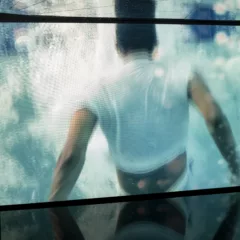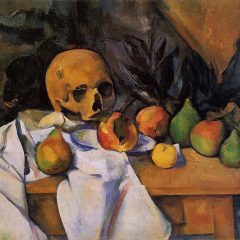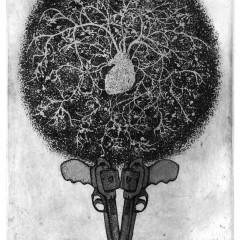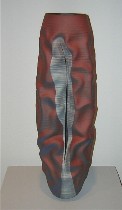 I went to the Philadelphia Art Alliance to check out Samantha Simpson, and on my way up to the third floor I passed some really great clay pots by Nicholas Arroyave-Portela.
I went to the Philadelphia Art Alliance to check out Samantha Simpson, and on my way up to the third floor I passed some really great clay pots by Nicholas Arroyave-Portela.
The turned shapes are distorted by punching or crumpling, and the two-tone colors breathe with the shape. Although these are essentially traditional thrown shapes, they have been rendered non-functional, by-in-large. (Image top, “Tall Terracotta shlashed crumpled form …” and detail right.)
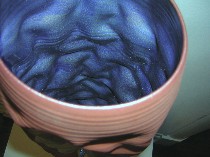 The show description compares the work to Lucio Fontana, Anish Kapoor and Mark Rothko, but I’d have to take a step back from that. The intensity of a spiritual experience and a willingness to go to extremes is not quite there; on the other hand, the work has a skin and anthropomorphic quality that gives it life, if not pulsating Presence.
The show description compares the work to Lucio Fontana, Anish Kapoor and Mark Rothko, but I’d have to take a step back from that. The intensity of a spiritual experience and a willingness to go to extremes is not quite there; on the other hand, the work has a skin and anthropomorphic quality that gives it life, if not pulsating Presence.
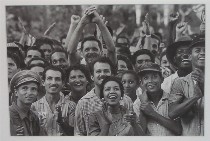 Also on the way up to Simpson’s work were Burt Glinn’s photos of Cuba right after Castro’s victory. Fine photojournalism, indeed. The people are filled with revolutionary fever, Castro is youthful, and everyone looks a lot healthier and wealthier than they do now. (Image, “…and responds with delight…” to Castro’s arrival on the podium.)
Also on the way up to Simpson’s work were Burt Glinn’s photos of Cuba right after Castro’s victory. Fine photojournalism, indeed. The people are filled with revolutionary fever, Castro is youthful, and everyone looks a lot healthier and wealthier than they do now. (Image, “…and responds with delight…” to Castro’s arrival on the podium.)
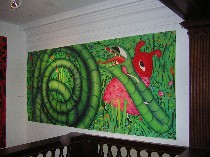 Simpson’s mural-sized pieces continue to please with their wonderful storybook charm mixed with gorgeous color and decorative elements. The new, site-specific painting, “Pokeweed Alley (Grip and the Nevermore Raven with Respective Badgers)” continues using badgers, snakes and stenciled on motifs used in previous work. The two badgers were especially beautiful, with their flowered clothes, a nearly matched pair. The oldest of the three large pieces, “Mythologizing Back” (shown) was the most simple, graphically, but it was “Peony,” with its ambiguous, layered space and content that interested me most (although I confess I love all of her work).
Simpson’s mural-sized pieces continue to please with their wonderful storybook charm mixed with gorgeous color and decorative elements. The new, site-specific painting, “Pokeweed Alley (Grip and the Nevermore Raven with Respective Badgers)” continues using badgers, snakes and stenciled on motifs used in previous work. The two badgers were especially beautiful, with their flowered clothes, a nearly matched pair. The oldest of the three large pieces, “Mythologizing Back” (shown) was the most simple, graphically, but it was “Peony,” with its ambiguous, layered space and content that interested me most (although I confess I love all of her work).
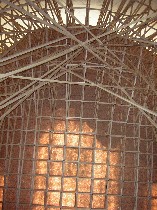
Also at the Art Alliance were Brian David Dennis‘ “Leaning Keep” (left), a site-specific installation that blocked the light in the stairway in protest of the security measures now infringing on freedom (I take this to mean the Patriot Act).
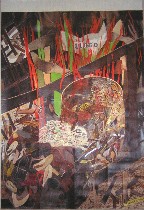
And in the first floor galleries, Tamar Hirschl’s mostly AbEx paintings focusing on her own experiences with war, violence, past and present. Born in Zagreb, she moved to Israel in 1948 and studied art there, moving here relatively recently. That arc of experience and transience informs her work (image right, “Fragmented Memories”).
Over at the Art Alliance Annex, Tadashi Moriyama’s paintings also reflect the experience of shifting cultures.
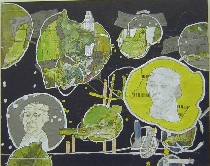
His mix of cartoony imagery, including UPC coding for polyp-like creatures, distorted planets, rickety planes, bending buildings and floating money and abstract expressionist layers of paint often hits the nail on the head with emotional truth. Moriyama brings a wry point of view as a stranger in a strange land (image left, “Temporary Planets With Bills and Coins”), and a sort of queasiness from the shifts in terrain.
The paintings range from tiny (approx. 3″ x 2″) to enormous (6 or 7 feet wide). Overall, this was promising, witty work worth some time.


